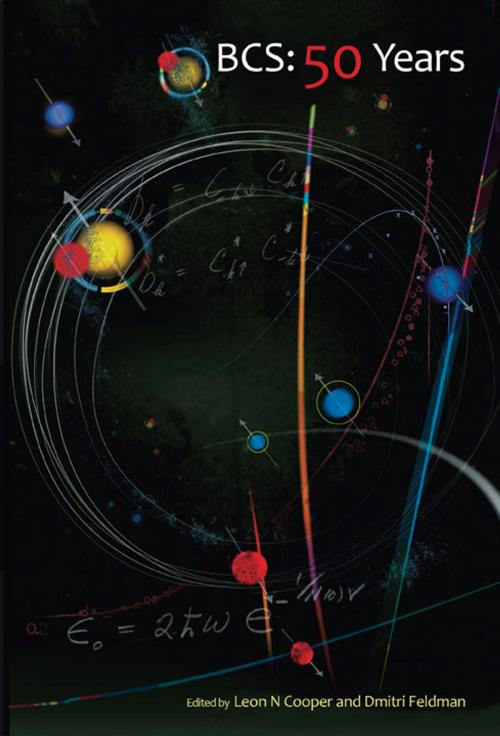BCS: 50 Years
Nonfiction, Science & Nature, Technology, Superconductors & Superconductivity, Science, Other Sciences, Scientific Instruments| Author: | Leon N Cooper, Dmitri Feldman | ISBN: | 9789814360869 |
| Publisher: | World Scientific Publishing Company | Publication: | November 10, 2010 |
| Imprint: | WSPC | Language: | English |
| Author: | Leon N Cooper, Dmitri Feldman |
| ISBN: | 9789814360869 |
| Publisher: | World Scientific Publishing Company |
| Publication: | November 10, 2010 |
| Imprint: | WSPC |
| Language: | English |
Named a Top Five Book of 2011 by Physics Today, USA.
The BCS theory of superconductivity developed in 1957 by Bardeen, Cooper and Schrieffer has been remarkably successful in explaining the properties of superconductors. In addition, concepts from BCS have been incorporated into diverse fields of physics, from nuclear physics and dense quark matter to the current standard model. Practical applications include SQUIDs, magnetic resonance imaging, superconducting electronics and the transmission of electricity. This invaluable book is a compilation of both a historical account and a discussion of the current state of theory and experiment.
With contributions from many prominent scientists, it aims to introduce students and researchers to the origins, the impact and the current state of the BCS theory.
Contents:
-
Historical Perspectives:
- Remembrance of Superconductivity Past (L N Cooper)
- The Road to BCS (J R Schrieffer)
- Development of Concepts in Superconductivity (J Bardeen)
- Failed Theories of Superconductivity (J Schmalian)
- Nuclear Magnetic Resonance and the BCS Theory (C P Slichter)
- Superconductivity: From Electron Interaction to Nuclear Supefluidity (D Pines)
- Developing BCS Ideas in the Former Soviet Union (L P Gor'kov)
- BCS: The Scientific “Love of My Life” (P W Anderson)
-
Fluctuations, Tunneling and Disorder:
- SQUIDs: Then and Now (J Clarke)
- Resistance in Superconductors (B I Halperin et al.)
- Cooper Pair Breaking (P Fulde)
- Superconductor-Insulator Transitions (A M Goldman)
- Novel Phases of Vortices in Superconductors (P Le Doussal)
- Breaking Translational Invariance by Population Imbalance: The Fulde–Ferrell–Larkin–Ovchinnikov States (G Zwicknagl & J Wosnitza)
-
New Superconductors:
- Predicting and Explaining Tc and Other Properties of BCS Superconductors (M L Cohen)
- The Evolution of HTS: Tc-Experiment Perspectives (C W Chu)
- The Evolution of High-Temperature Superconductivity: Theory Perspective (E Abrahams)
-
BCS Beyond Superconductivity:
- The Superfluid Phases of Liquid 3He: BCS Theory (A J Leggett)
- Superfluidity in a Gas of Strongly Interacting Fermions (W Ketterle et al.)
- BCS from Nuclei and Neutron Stars to Quark Matter and Cold Atoms (G Baym)
- Energy Gap, Mass Gap, and Spontaneous Symmetry Breaking (Y Nambu)
- BCS as Foundation and Inspiration: The Transmutation of Symmetry (F Wilczek)
- From BCS to the LHC (S Weinberg)
Readership: Students, researchers and academics interested in BCS theory and its origin.
Key Features:
- Unique, personal historical accounts from very well known contributors
- An update on the current status of the field
Named a Top Five Book of 2011 by Physics Today, USA.
The BCS theory of superconductivity developed in 1957 by Bardeen, Cooper and Schrieffer has been remarkably successful in explaining the properties of superconductors. In addition, concepts from BCS have been incorporated into diverse fields of physics, from nuclear physics and dense quark matter to the current standard model. Practical applications include SQUIDs, magnetic resonance imaging, superconducting electronics and the transmission of electricity. This invaluable book is a compilation of both a historical account and a discussion of the current state of theory and experiment.
With contributions from many prominent scientists, it aims to introduce students and researchers to the origins, the impact and the current state of the BCS theory.
Contents:
-
Historical Perspectives:
- Remembrance of Superconductivity Past (L N Cooper)
- The Road to BCS (J R Schrieffer)
- Development of Concepts in Superconductivity (J Bardeen)
- Failed Theories of Superconductivity (J Schmalian)
- Nuclear Magnetic Resonance and the BCS Theory (C P Slichter)
- Superconductivity: From Electron Interaction to Nuclear Supefluidity (D Pines)
- Developing BCS Ideas in the Former Soviet Union (L P Gor'kov)
- BCS: The Scientific “Love of My Life” (P W Anderson)
-
Fluctuations, Tunneling and Disorder:
- SQUIDs: Then and Now (J Clarke)
- Resistance in Superconductors (B I Halperin et al.)
- Cooper Pair Breaking (P Fulde)
- Superconductor-Insulator Transitions (A M Goldman)
- Novel Phases of Vortices in Superconductors (P Le Doussal)
- Breaking Translational Invariance by Population Imbalance: The Fulde–Ferrell–Larkin–Ovchinnikov States (G Zwicknagl & J Wosnitza)
-
New Superconductors:
- Predicting and Explaining Tc and Other Properties of BCS Superconductors (M L Cohen)
- The Evolution of HTS: Tc-Experiment Perspectives (C W Chu)
- The Evolution of High-Temperature Superconductivity: Theory Perspective (E Abrahams)
-
BCS Beyond Superconductivity:
- The Superfluid Phases of Liquid 3He: BCS Theory (A J Leggett)
- Superfluidity in a Gas of Strongly Interacting Fermions (W Ketterle et al.)
- BCS from Nuclei and Neutron Stars to Quark Matter and Cold Atoms (G Baym)
- Energy Gap, Mass Gap, and Spontaneous Symmetry Breaking (Y Nambu)
- BCS as Foundation and Inspiration: The Transmutation of Symmetry (F Wilczek)
- From BCS to the LHC (S Weinberg)
Readership: Students, researchers and academics interested in BCS theory and its origin.
Key Features:
- Unique, personal historical accounts from very well known contributors
- An update on the current status of the field















